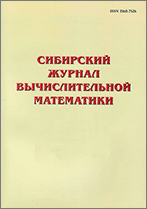|
This article is cited in 12 scientific papers (total in 12 papers)
Discrete maximum-norm stability of a linearized second order finite difference scheme for Allen–Cahn equation
T. Hou, K. Wang, Y. Xiong, X. Xiao, Sh. Zhang
School of Mathematics and Statistics, Beihua University, Jilin, 132013, China
Abstract:
In this paper, we use finite difference methods for solving the Allen–Cahn equation which contains small perturbation parameters and strong nonlinearity. We consider a linearized second-order three level scheme in time and a second-order finite difference approach in space, and we establish discrete boundedness stability in maximum norm: if the initial data is bounded by 1, then the numerical solutions in later times can also be bounded uniformly by 1. We will show that the main result can be obtained under certain.
Key words:
Allen–Cahn equation, finite difference method, discrete boundedness stability, maximum norm.
Received: 02.05.2016
Revised: 08.10.2016
Citation:
T. Hou, K. Wang, Y. Xiong, X. Xiao, Sh. Zhang, “Discrete maximum-norm stability of a linearized second order finite difference scheme for Allen–Cahn equation”, Sib. Zh. Vychisl. Mat., 20:2 (2017), 215–222; Num. Anal. Appl., 10:2 (2017), 177–183
Linking options:
https://www.mathnet.ru/eng/sjvm647 https://www.mathnet.ru/eng/sjvm/v20/i2/p215
|

| Statistics & downloads: |
| Abstract page: | 259 | | Full-text PDF : | 65 | | References: | 54 | | First page: | 10 |
|




 Contact us:
Contact us: Terms of Use
Terms of Use
 Registration to the website
Registration to the website Logotypes
Logotypes








 Citation in format
Citation in format 
